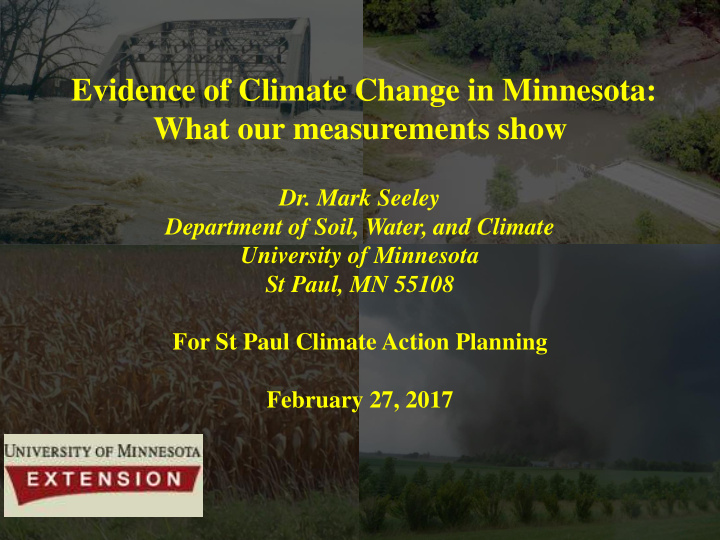



Evidence of Climate Change in Minnesota: What our measurements show Dr. Mark Seeley Department of Soil, Water, and Climate University of Minnesota St Paul, MN 55108 For St Paul Climate Action Planning February 27, 2017
2015-16 Avg Dept. from Month Temp 1981-2010 Normal Sep-Nov ----------------------------------------- Twin Cities Monthly Temps September 67.9 + 5.9 October 52.1 + 3.2 November 44.1 +10.4 December 30.2 +10.5 January 17.6 + 2.0 February 24.9 + 4.0 March 41.3 + 8.5 April 48.1 + 0.6 May 61.3 + 2.2 June 71.3 + 2.4 July 75.2 + 1.4 August 73.4 + 2.2 September 66.1 + 4.1 October 52.9 + 4.0 November 44.1 +10.4 December 20.9 + 1.2 Jan’17 20.7 + 5.1*projected 17 consecutive months warmer than normal Kandi ndiyohi ohi Coun unty Fair irgrou ounds nds after r flash h flood ood Aug 10-11, 2016
Di Dispar arity ty in th the e pac ace e of climate te chan ange e rel elati tive e to to te temper eratur ture
Minnesota esota Mea ean Annual al Tem emper eratur ture e Tren ends ds Temp trend is upward and more frequently above the 90 th percentile, pace is 2°F per century.
Twin Citi ties es Mea ean Annual ual Tem emper eratur ture e Tren ends ds Temp trend is upward and more frequently above the 80 th percentile, pace is 3°F per century.
Change in average winter minimum temperature is 4°F per century in the Twin Cities climate record
Minnesota State-Averaged Temperature Trends 1895-2013 8.0 7.0 6.0 degrees F per century 5.0 4.0 3.0 2.0 1.0 0.0 -1.0 -2.0 -3.0 January February March April May June July August September October November December Annual Maximum Temperature Trend Minimum Temperature Trend Difference (Max minus Min)
Trend in dewpoints of 70 F or higher in the Twin Cities Annual Hours of Dew Point Temperature => 70 Latitude 45 degrees degrees F Minneapolis/St. Paul, MN 600 500 400 hours 300 200 100 0 1970 1971 1972 1973 1974 1975 1976 1977 1978 1979 1980 1981 1982 1983 1984 1985 1986 1987 1988 1989 1990 1991 1992 1993 1994 1995 1996 1997 1998 1999 2000 2001 2002 2003 2004 2005 2006 2007 2008 2009 2010 2011 2012 2013 year annual total Hours with dewpoints of 70 degrees F or higher at Voyageurs National Park Latitude 48.5 degrees
Frequencies of tropical-like dew points (70 F or higher) and associated Heat Index values for the Twin Cities since 1945 Year Hours with DP of Range of Heat 70 F or greater Index Values (F) 1947 256 99 - 112 1949 303 98 - 112 1955 345 98 - 113 1957 243 98 - 112 1959 317 99 - 113 1960 259 98 - 112 1978 252 99 - 114 1983 392 102 - 110 1987 302 98 - 104 1995 387 98 - 116 1997 264 98 - 113 1999 254 98 – 116 2001 357 98 - 110 2002 512 98 – 109 2010 256 98 - 111 2011 347 98 – 118 (*134) 2013 248 99 - 105
July 19-20, 2011 Heat Wave Heat Index: 112°F Faribault 114°F Mankato 114°F New Ulm 114°F Waseca 117°F Owatonna 118°F Red Wing 119°F Twin Cities 110°F Albert Lea 114°F St James 114°F Fairmount 121°F Austin 134°F Moorhead
Consequences of Warmer Temperatures Change in depth and duration of soil and lake freezing Change in survival rates of insect pests, parasites, plant pathogens, and soil microbes Reduced Heating Degree Days (HDD), increased Cooling Degree Days (CDD) Increased annual number of freeze/thaw cycles Change in Plant Hardiness Zones Longer growing seasons Change in exposure times to mold and allergens More use of air conditioning, exposure to Heat Waves
Geographic phic Dispari arity ty in Precip ipita itati tion on Chang nge-IPC IPCC 2013
Trend nd in annua ual precipi ipita tation tion for MN
Trend nd in annua ual precipi ipita tation tion for Twin n Cities
Change in Annual Precipitation “ Normals ” for Minneapolis/St Paul, MN PERIOD AMOUNT (IN.) 1941-1970 25.93” 1951-1980 26.36” 1961-1990 28.36” 1971-2000 29.40” 1981- 2010 31.16” 20 percent increase since 1941-1970 period Extremes: 11.54” in 1910, 40.15” in 1911
Worst st flash h flood in Twin Cities es histo tory ry Deliver ered ed 10 inches es of rain in 6 hours
July ly 23-24, 24, 1987 7 in the Twin in Citie ties 10” in 6 hours, and 17.90” for the month
Observations – Minnesota Trends Minnesota Mega-rain Events August 6, 1866, Southern Minnesota July 17-19 1867, Central Minnesota July 20-22, 1909, Northern Minnesota September 9-10, 1947 Iron Range July 21-22, 1972, Grand Daddy Flash Flood June 28-29, 1975, Northwest Minnesota July 23-24, 1987, Twin Cities Superstorm June 9-10, 2002, Northern Minnesota September 14-15, 2004 Southern Minnesota August 18-20, 2007, Southern Minnesota September 22-23, 2010 Southern Minnesota June 19-20, 2012, Northeast Minnesota July 11-12, 2016 central and east-central Minnesota August 10-11, 2016 west-central and southeastern Minnesota *Defined as 6” or greater rains cover at least 1000 square miles and a peak amount of 8” or greater
Shift in Precipitation Recurrence Intervals Mega Rains since 2002
Consequences of Changes in Precipitation Quantity and Character Altered irrigation, tile drainage, runoff, sediment, and shoreline management Farm field and watershed buffer strips Change in storm sewer design More emphasis on erosion control Mitigation of flooding potential Impact on insurance risk and claims
Recommend
More recommend